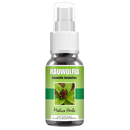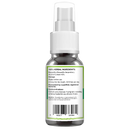Description
Latin: Rauwolfia serpentina Sanskrit: Sarpaghandha African: Numerous (R. vomitoria species) Chinese: Lu fu mu (various species) English: Rauwolfia / Indian snakeroot
WHAT IT DOES: Rauwolfia root is bitter in taste and cooling in action. It lowers blood pressure, tranquilizes the mind, and promotes sleep. RATING: Red, due to safety issues.
SAFETY ISSUES: Use only under the guidance of a trained physician or herbalist in the proper dosage. Do not use it in pregnancy, breastfeeding, or depression. May exacerbate symptoms of Parkinson's Disease. Do not combine with alcohol, barbiturates (Pfeifer et al., 1976), SSRIs, blood-pressure-lowering agents such as beta-blockers, unless under guidance.
STARTING DOSAGE: Tincture (standardized to 1.0% w/v total alkaloids): two to 12 drops three times per day Rauwolfia is a reliable blood pressure lowering and the tranquilizing agent when used properly. It is used in traditional medicine in India, China, Africa, and many other countries. In India and Nepal, it is a common treatment for hypertension and insomnia. Ghandhi took it frequently at night for its calming actions. It warrants a red rating because of its ability to cause severe reactions in overdose, including trembling and collapse. Reserpine, the chief alkaloid in rauwolfia root, seems to be the component responsible for its blood pressure-lowering activity. Doctors began using reserpine-based hypertension medicines in the 1950s, but they went out of favor because of the side effects, chiefly depression (Weiss, 1988). Consequently, rauwolfia can only be acquired from a licensed health care professional. During the scientific controversy in the 1950s surrounding the question of whether reserpine by itself was superior to the whole rauwolfia root, an Indian physician named Dr. Vakil reviewed all 151 studies available at the time. He came to the conclusion that the combined action of the whole root improves tolerance and reduces the risk of side effects that occur with the use of isolated alkaloids (reported in Weiss, 1988). In collaboration with Western doctors, I have used a rauwolfia tincture safely to treat dozens of mild to moderate hypertension patients. We combine 30-50% of a standardized whole root tincture with other mild herbal tinctures known to lower blood pressure, such as linden flowers and mistletoe. In mild cases, we start with two drops three times per day and perform regular blood pressure checks, instructing the patient to increase the dosage until the blood pressure normalizes or they reach the limit in dosage. Patients marvel at how effectively they can control their pressure drop by drop and control the dosage to manage day-to-day variations - especially important in patients with stress-related hypertension. We stop dosing at well below the levels where side effects usually develop. If it does not sufficiently lower the patient’s pressure, the doctors will prescribe mild Western medication at a lower-than-normal dosage. This combination treatment will often work. Rauwolfia root is not curative. Following traditional Ayurvedic procedures, once we have controlled the blood pressure we employ other herbal agents and lifestyle changes to resolve the underlying problems, especially hawthorn. Blood pressure increases are often the result of plaques in the vessels, reduced kidney function and concomitant retention of fluids, and diet errors.
Research Highlights The mechanism of action of rauwolfia root differs from most other blood-pressure-lowering agents, acting on the central nervous system. This may explain why it works when other medicines fail (Weiss, 1988, Shibuya and Sato, 1985). • In doses higher than those used for hypertension, rauwolfia alkaloids cause a depletion of norepinephrine, resulting in a tranquilizing effect. Very high doses can cause a loss of coordination (reported in Huang, 1999). Many patients who take medication to control hypertension still have problems with balance, due to difficulties in circulatory regulation. Upon examination of blood-pressure-lowering agents available up to 1980, researchers discovered that only Rauwolfia alkaloids and clonidine do not have an undesirable influence on balance (Teichmann and Vogel, 1980). In a Chinese study on 200 patients with moderate hypertension, rauwolfia alkaloids lowered blood pressure was reduced by as much as 30-40% with minimal side effects (reported in Huang, 1999). Rauwolfia root has proven highly effective (89%) in cases of chronic hives (reported in Huang, 1999). The pharmacological effects of reserpine were formerly caused for concern that it might promote breast cancer. However, in epidemiological studies, rauwolfia alkaloids did not increase the risk of breast cancer (Shapiro et al., 1984, von Poser et al., 1990). Rauwolfia root has occasionally proven effective in cases of malnutrition that were unresponsive to high protein or high-energy diets (reported in Huang, 1999).




